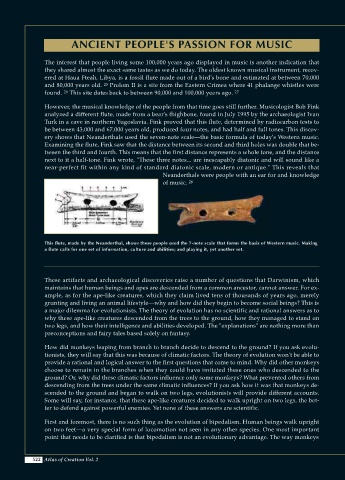Page 524 - Atlas of Creation Volume 2
P. 524
ANCIENT PEOPLE'S PASSION FOR MUSIC
The interest that people living some 100,000 years ago displayed in music is another indication that
they shared almost the exact same tastes as we do today. The oldest known musical instrument, recov-
ered at Haua Fteah, Libya, is a fossil flute made out of a bird's bone and estimated at between 70,000
and 80,000 years old. 25 Prolom II is a site from the Eastern Crimea where 41 phalange whistles were
found. This site dates back to between 90,000 and 100,000 years ago. 27
26
However, the musical knowledge of the people from that time goes still further. Musicologist Bob Fink
analyzed a different flute, made from a bear's thighbone, found in July 1995 by the archaeologist Ivan
Turk in a cave in northern Yugoslavia. Fink proved that this flute, determined by radiocarbon tests to
be between 43,000 and 67,000 years old, produced four notes, and had half and full tones. This discov-
ery shows that Neanderthals used the seven-note scale—the basic formula of today's Western music.
Examining the flute, Fink saw that the distance between its second and third holes was double that be-
tween the third and fourth. This means that the first distance represents a whole tone, and the distance
next to it a half-tone. Fink wrote, "These three notes... are inescapably diatonic and will sound like a
near-perfect fit within any kind of standard diatonic scale, modern or antique." This reveals that
Neanderthals were people with an ear for and knowledge
of music. 28
This flute, made by the Neanderthal, shows these people used the 7-note scale that forms the basis of Western music. Making
a flute calls for one set of information, culture and abilities; and playing it, yet another set.
These artifacts and archaeological discoveries raise a number of questions that Darwinism, which
maintains that human beings and apes are descended from a common ancestor, cannot answer. For ex-
ample, as for the ape-like creatures, which they claim lived tens of thousands of years ago, merely
grunting and living an animal lifestyle—why and how did they begin to become social beings? This is
a major dilemma for evolutionists. The theory of evolution has no scientific and rational answers as to
why these ape-like creatures descended from the trees to the ground, how they managed to stand on
two legs, and how their intelligence and abilities developed. The "explanations" are nothing more than
preconceptions and fairy tales based solely on fantasy.
How did monkeys leaping from branch to branch decide to descend to the ground? If you ask evolu-
tionists, they will say that this was because of climatic factors. The theory of evolution won't be able to
provide a rational and logical answer to the first questions that come to mind. Why did other monkeys
choose to remain in the branches when they could have imitated these ones who descended to the
ground? Or, why did these climatic factors influence only some monkeys? What prevented others from
descending from the trees under the same climatic influences? If you ask how it was that monkeys de-
scended to the ground and began to walk on two legs, evolutionists will provide different accounts.
Some will say, for instance, that these ape-like creatures decided to walk upright on two legs, the bet-
ter to defend against powerful enemies. Yet none of these answers are scientific.
First and foremost, there is no such thing as the evolution of bipedalism. Human beings walk upright
on two feet—a very special form of locomotion not seen in any other species. One most important
point that needs to be clarified is that bipedalism is not an evolutionary advantage. The way monkeys
522 Atlas of Creation Vol. 2

